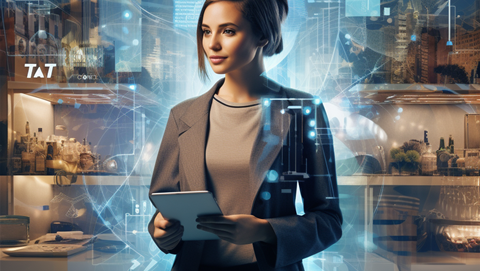Smart Industry is characterised by digital technologies such as the Internet of Things (IoT), artificial intelligence (AI), big data analytics and automation integrated into the production process. It is
And it enables businesses to operate autonomously in highly connected ways, lifting efficiency, flexibility, customer experience, and resilience to outside shocks.
The ‘building blocks’ of Smart Industry are embedded in technology domain specialisations across digital transformation, data & analytics and AI, applications, edge devices, connectivity & cloud. As businesses embrace new technologies to modernise their business environments, they are creating the foundation for benefiting from Smart Industry innovation.
Organisations in sectors as diverse as agriculture, manufacturing and even the public sector are implementing Smart Industry approaches to improve their operations and be more competitive, said Anthony Doig, vice president of strategy and solutions at the global digital engineering powerhouse, Akkodis.
Doig said one of Smart Industry’s greatest benefits is how it helps people make better decisions, faster.
“Businesses can potentially automate process tasks and keep staff and customers informed about services or operations while capturing new opportunities,” Doig said.
“So smart industry is about connecting people, new skills, existing business knowledge and taking up those change initiatives to implement them successfully.”
Each year, 38,000 people go missing in Australia, and looking for them in the Outback presents particular dilemmas for rescuers. Akkodis collaborated with police to ensure they had the most up-to-date information even while trawling harsh and remote landscapes for missing people.
“Police officers were able to get the right resources to the right person very rapidly because we've connected people in the field back to those core information systems,” Doig said.
Digital Twins and IoT speed decision-making in remote, difficult and complex environments
Computer simulations of the real world also help businesses manage complex operations. Such ‘Digital Twins’ that recreate physical infrastructure along with the laws of physics, economic models and business rules empower decision-makers to improve efficiency without risking the real infrastructure, Doig said
“One of the purposes of a Digital Twin is not only to visualise current state, but to run simulations around what could happen next? If I add more mine trucks into my mine site, can I get more productivity out of my mine?” he said
The ease with which Digital Twins may be manipulated is attractive to other infrastructure and heavy industry providers such as electricity and gas companies. For instance, power companies model demand based on historical use and weather forecasts arrayed against real-time sensor information from rooftop solar systems and other inputs.
“At Akkodis, we're collecting the data off those sensors and ingesting them into a data lake [where we] run algorithms to predict what may happen next and simulate different conditions.” This data is then presented to power companies to help them align supply with demand in the grid, he said.
Sensors are also used at the individual device level to mediate interactions between driverless vehicles, said Joshua Morley, Akkodis national solutions and practice lead for IoT & digital twins.
“When you have two heavy vehicles approaching an intersection, they'll communicate” with each other, Morley said.
“One will slow down by a fraction to allow them both to pass without stopping because fuel usage of stopping and starting again for a heavy vehicle is significant. So by slowing one down by a fraction, they can bypass each other at a safe distance.”
Such technologies also greatly cut the incidence of costly and hazardous accidents that may have lasting or knock-on effects. Australia’s miners operate two-thirds of the world’s 1100-plus driverless haul trucks, responsible for conveying billions of tonnes of material a year.
The easy way to an ‘A’ – Modelling the model student
Even in the classroom, Smart Industry models are having an effect. Morley said analysis of student activities could lift their grades by choosing certain activities or classes in combination.
“We found the degree of accuracy of the model was so high that we were able to effectively determine what influencing factors were making up the end outcome,” he said.
Morley said the lesson for Australian business leaders is that, no matter their industry, Smart Industry has arrived — and is probably already making its effects known in their sector.
“Analysts at McKinsey estimates that the total value to be captured by IoT — just one component of Smart Industry — will be $US12.6 trillion in 2030,” Morley said.
“So, Smart Industry isn't a buzzword, sales tactic or future prospect. It's already here and it's happening all around us. You can embrace it or you can fall behind.”
From steam engines to smart agents in 300 years
First Industrial Revolution – As early as the 17th century, steam engines pumped water out of coalmines and would later power mass production and heavy transportation to get more goods to market, at unprecedented speed, all over the globe.
Second Industrial Revolution – From the 19th century, rapid technological progress led to mass production, electrification and spread of telecommunications connecting industrial centres with each other and consumers, further lowering costs and creating the middle class.
Third Industrial Revolution – AKA the ‘Digital Revolution’ was the rise in the 1970s–’90s of technologies such as the personal computer and internet that marked the shift from mechanical to digital technologies.
Fourth Industrial Revolution – At the start of the 21st century, a period distinguished by a world of hyper-automation where “cyber-physical systems” exchange data between themselves, fed by ubiquitous sensors and mediated in the cloud by artificial intelligences.
Visit Akkodis Australia to learn how the global digital engineering powerhouse can speed your energy and clean technology transformation.
















.png&h=271&w=480&c=1&s=1)









